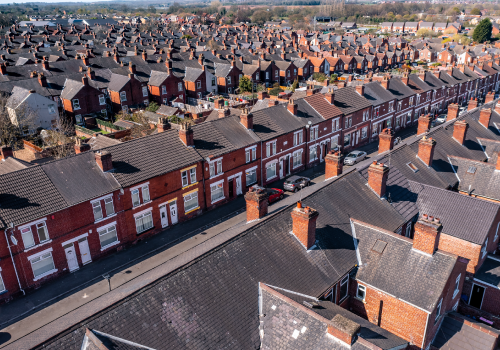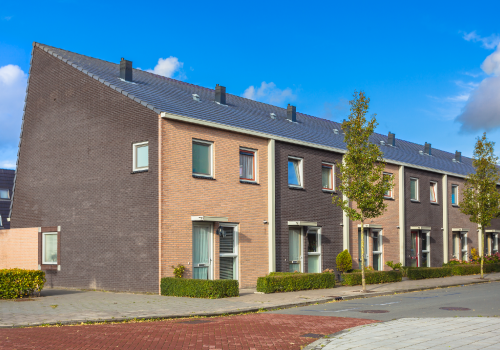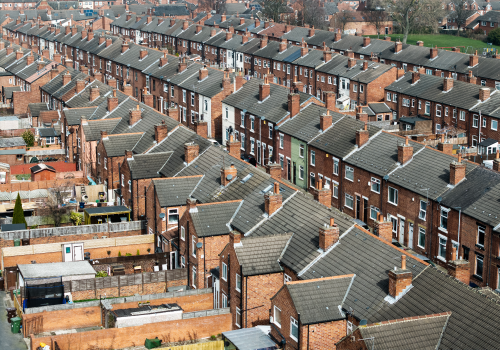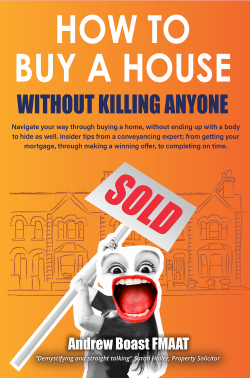The Complete Guide on Buying a Terraced House
Terraced Houses are the most common property type in England, with 6.93 million properties accounting for 26.3% of the total housing stock.
These homes often offer a good number of bedrooms, with a significant proportion having three (56%) or two (32%). Their relative affordability and the sense of community often associated with terraced streets make them a popular choice, especially as a first home for families.
However, Terraced Houses are not without their challenges: more fire risks, the possibility of neighbour disputes, and even freehold management companies. More affordability = the potential for more headaches.
Regional Distribution of Terraced Houses: Terraced houses are particularly prevalent in the North West (34% of the housing stock) and Yorkshire and The Humber (33%) regions of England, reflecting their historical development and continued popularity in these areas.
(Source: ONS - Council Tax: stock of properties Statistical Summary).
What does 'Terraced House' mean?
The fundamental definition of a terraced house is a property part of a continuous row of similar houses joined side by side, usually with one roof and ridge that joins all houses together. These houses share side walls; only the houses at the ends of the row (end-terraces) have exposed side walls.
The term 'terraced house' has its roots in the early development of this housing style in the UK. Some of the earliest examples were built with a communal garden terrace at the rear, providing shared outdoor space for the residents.
While the prevalence of communal terraces has decreased over time, the name has stuck, referring to the uniform row of attached houses.
Terraced houses are common in towns and cities across the UK, offering a blend of affordability, space efficiency, and community living. They come in various sizes and styles, from smaller one-bedroom homes to larger multi-story townhouses.
How much does a Terraced House cost?
According to the latest data from the House Price Index (HPI) in January 2025, the average cost of a terraced property in England and Wales was £235,649.
This makes them significantly more affordable than detached (and link-detached) houses, which averaged £461,383 during the same period.
To provide further context, let's compare the average cost of a terraced house to other common property types in England and Wales (January 2025, HPI):
- Semi-detached: £280,553.
- Flats and Maisonettes: £222,363.
As you can see, on average, a terraced house is more affordable than a semi-detached property but slightly more expensive than a flat or maisonette.
This affordability, coupled with the often larger number of bedrooms compared to flats, makes them an attractive option for many buyers.
Important Note: These are national averages. The actual cost of a terraced house can vary significantly depending on the specific region, city, and even the particular street. For example, you would typically expect to pay more for a terraced house in London compared to the North of England.
Additionally, the condition of the property, its size, and any unique features will also play a significant role in its price. It's always recommended to consult local estate agents and review up-to-date market reports for the most accurate pricing information in your area of interest.
Interestingly, data from the same government source indicates a significant proportion of terraced houses fall into the lower Council Tax bands.
Around 33% of terraced properties in England are in Council Tax band A, which typically includes properties with the lowest valuation. This further highlights the relative affordability of many terraced homes.

- No Sale, No Fee (Auction, Right to Buy, and Repossession excluded).
- Initial deposit applied to your second transaction with no questions asked or time limits.
- Fixed fee quotes.
- We are on 99% of mortgage lender panels.
- We can solve any property challenge.



Types of Terraced Houses
While the fundamental characteristic of a terraced house is being part of a row of attached properties, there are a few common variations you might encounter:
Middle Terrace
This is the most common type of terraced house. It's in the middle of a row and shares both side walls with its neighbouring properties.
End Terrace
As the name suggests, an end-terrace house is at either end of a row. It shares only one side wall and typically has an exposed wall on the other side, often allowing for more natural light and sometimes a slightly larger garden or plot of land compared to middle terraces.
Back-to-Back Terrace
This type of terraced house is less common today but can still be found in some older industrial areas. Back-to-back terraces are joined at the rear and the sides, meaning they often don't have a traditional rear garden and might have direct access to living areas from the front.

How To Buy A House Without Killing Anyone could be the difference between every mover’s dream.
Buying and moving into your new home stress-free, or, stress, missed deadlines, legal disasters, building defects, and possibly the collapse of the whole transaction.
(Costing you a small fortune, a head full of grey hairs, and, driving you to threaten the life of your solicitor, lender, co-owners, family, partner, or some combination of all five).
Available on Amazon | Kindle | Paperback
Pros and Cons of Terraced Houses
-
More Bedrooms
Terraced houses are often built with multiple stories, typically offering more bedrooms compared to single-story flats or bungalows, which is ideal for growing families or those needing extra space for guests or a home office. -
Increasing in Number
Terraced houses remain a popular choice for developers and continue to form a significant portion of new housing developments, especially in urban areas where space is at a premium. This means a good supply of options for buyers in many locations. -
More Affordable for Space
Generally, terraced houses provide a larger square footage of living space for a lower purchase price compared to detached and semi-detached properties in the same area, making them a more accessible option for buyers on a budget. -
Often Come with a Garden
Many traditional and modern terraced houses include a private garden space, offering valuable outdoor areas for relaxation, recreation, and even potential extensions (subject to regulations). -
Potential for Conversion
Larger terraced houses, especially those in central locations, can sometimes be converted into multiple self-contained flats, which can be an attractive investment opportunity for landlords looking to generate rental income. -
Cheaper Building Insurance
Building insurance premiums for terraced houses are often lower than for detached properties because they have fewer exposed external walls, reducing the overall risk of damage from weather-related events.
-
Noise from Neighbours
Sharing walls on both sides with neighbouring properties can sometimes lead to issues with noise transfer, potentially impacting privacy and peace, especially if sound insulation is poor. -
Boundary Disputes
Disagreements over the exact location of boundary lines, shared fences, and parking arrangements can occasionally arise between neighbours in terraced streets, potentially leading to disputes that are costly and time-consuming to resolve. -
Fire Risk
As highlighted in our article on loft party wall fire regulations, there can be specific fire safety considerations in terraced houses, particularly concerning the shared loft space and party walls. -
Regional Availability
While common in many parts of the UK, the prevalence of terraced houses can vary significantly by region. In more rural or suburban areas, you might find fewer terraced properties available compared to other house types. -
Issues with Extensions
Extending a terraced house can be more complex and costly due to the need for party wall agreements with neighbours and potential restrictions on the size and design of extensions to avoid impacting adjoining properties. -
Impact of Neighbour's Property
The condition and upkeep of a neighbouring property can sometimes indirectly affect your own home. For example, issues like damp or structural problems in an adjacent house could potentially spread to yours.
Is building insurance cheaper on Terraced Houses?
According to data from MoneySuperMarket, building insurance for terraced houses is generally cheaper than for detached properties. This is often because terraced homes have fewer external walls exposed to the elements, which can reduce the risk of weather-related damage and, consequently, the likelihood of claims.
Additionally, the average rebuild cost for a terraced house might be lower than that of a larger detached property, which can also influence insurance premiums.
Top Tips when viewing a Terraced House
Check the roof and loft space
Ensure the connecting walls aren't damaged. Pay close attention to any signs of damp, leaks, or structural issues, especially around the party walls shared with your neighbours. Look for evidence of past repairs or any areas that might require attention.Look for signs of damp
Damp (rising or penetrating) can be a common issue in terraced houses due to shared walls, potentially leading to problems like mould and structural damage. Check for discolouration, peeling paint or wallpaper, and a musty smell, particularly on lower ground floors or around chimneys.The garden - is it private enough?
Consider the layout and boundaries of the garden. Are you overlooked by neighbouring properties? Is the fencing or walling adequate for your desired level of privacy? Think about how you plan to use the outdoor space and if the current setup meets your needs.Parking
On-street parking can affect your car insurance, but it can be even more frustrating when you can't park outside your home. Check the property at different times of day, especially in the evening, to see how readily available parking spaces are. Also, consider if there are any permit schemes or restrictions in place.Ask about the neighbours
Due to the close proximity in terraced housing, your neighbours can significantly impact your living experience. If possible, speak to the current neighbours to get a sense of the community and address any concerns you might have.Get a survey
Terraced properties are more likely to have defects due to their age and shared structure, so a RICS surveyor must flag potential defects now, and advise on how to maintain the property in the future. A thorough survey can identify issues that might not be obvious during a viewing and save you significant costs and headaches down the line.
Historical trends and new builds of Terraced Houses
Looking at the broader trends in housing stock, data from the Council Tax statistics provided by the government reveals interesting shifts in property types between 1993 and 2024.
In 1993, terraced houses accounted for approximately 32% of the total housing stock in England. By 2024, while still the most common type, this had decreased to around 25.9%.
This shift reflects the growth in other property types. Flats and maisonettes increased from about 18% in 1993 to 23.6% in 2024. Semi-detached houses, another common type, accounted for 23.7% of the stock in 2024.
Recent data for newly built homes from 2024 by the National House-Building Council (NHBC) indicates that terraced houses continue to be a significant part of new housing developments.
Out of the total new home registrations in that year, approximately 28% were for terraced houses. This demonstrates the ongoing demand for this type of property, particularly in areas where affordability and efficient use of space are key.

- Expert panel of conveyancing solicitors, with local knowledge.
- Your transaction is protected by our No Sale, No Fee policy. Terms apply.
- Fixed fee conveyancing.
- We are on 99% of mortgage lender panels.
- We can solve any property challenge.
Jack is our resident Content Writer with a wealth of experience in Marketing, Content, and Film. If you need anything written or proof-read at a rapid speed and high quality, he's your guy.
Caragh is an excellent writer and copy editor of books, news articles and editorials. She has written extensively for SAM for a variety of conveyancing, survey, property law and mortgage-related articles.









